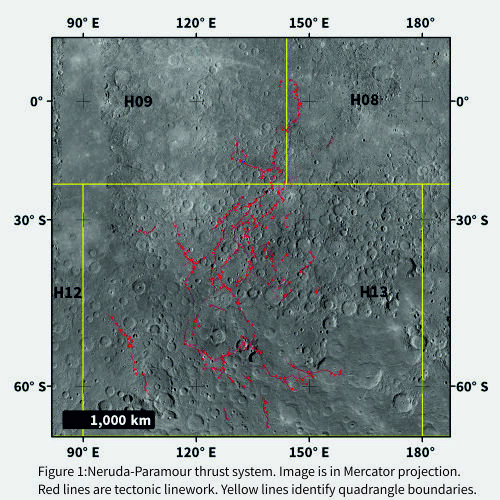Investigating the Neruda-Paramour thrust system, Mercury
- 1The Open University, Department of Physical Sciences, Milton Keynes, United Kingdom of Great Britain and Northern Ireland (ben.man@open.ac.uk)
- 2LPG Nantes - CNRS, Université de Nantes, France (susan.conway@univ-nantes.fr)
Abstract:
Our tectonic mapping as part of a larger morphostratigraphic mapping effort of the H13, Neruda Quadrangle (1) has led us to recognise the “Neruda-Paramour” thrust system. The system appears to extend from the southern limits of H13 north through H09 and H08 and simplifies at its northern end into Paramour Rupes (Figure 1). Mercury’s tectonic evolution is dominated by global scale contractional structures of which the Neruda-Paramour system is part of (2). These structures are believed to have formed either by secular cooling of the planet (3), tidal despinning (4), mantle overturn (5), true polar wander (6) or a combination of these processes. Regardless of the process, Mercury’s surface exhibits abundant evidence of global contraction in the form of shortening structures such as lobate scarps, high relief ridges and wrinkles ridges (7,8). These features are widely accepted as the surface expressions of thrust faulting and folding, produced by lithospheric horizontal compression. Often, these contractional features comprise major thrust systems as linked segments with a consistent trend (8). In order to understand the development of the Neruda-Paramour system and to ascertain if there is any sequence of movements, we are first mapping the system in its entirety followed by age dating of each thrust segment’s last movement using the buffered crater counting (BCC) technique.

Methods:
Tectonic lineament mapping
Primary basemap: Global ~166 mpp v1.0 BDR tiles with moderate (~74°) solar incidence angles.
Secondary basemaps: low (~45°) and high (~78°) incidence angle basemaps, ~665mpp enhanced colour mosaic; MLA- and stereo-derived DEMs.
Scale: 1:3M scale with digitisation at 1:300k.
Software: Esri ArcGIS 10.5.1 GIS software.
Buffered crater counting
Software: Esri ArcGIS 10.5.1 GIS software with CraterTools extension (9). CraterStats 2.0 (10).
We use the BCC technique by (8,11) which counts craters that are unfaulted and undeformed by the structures under investigation to derive absolute model ages of linear landforms. The BCC technique uses a buffer zone around the linear feature to include more craters to be taken into consideration for the crater size frequency distribution (CSFD) count. This addition of included craters produces a more robust measurement, which is important due to the restricted surface area that the structures occupy (12). We have chosen to consider all craters that directly intersect the structures ≥2 km. A fault buffer width of 2R (R=radius of the crater) for buffer generation is used. CSFD data is exported to CraterStats 2.0 where it is plotted in a log Ncum (cumulative crater frequency) vs log D (diameter) and using the production function (PF) a best fit of the CSFD data is made, giving an absolute model age value. The Neukum Production Function and Le Feuvre and Wieczorek Production Function are used and the results from each are compared. Method after (8).
Results:
We will present our analysis of the mutual age relationships between elements of the Neruda-Paramour thrust system and discuss the implications for the tectonics of this part of the globe.
Acknowledgements:
Mapping is in association with Planmap, funded through the EU Horizon 2020 research and innovation programme under grant agreement No. 776276. Ben Man is supported by STFC and the Open University’s Space Strategic Research Area.
References:
How to cite: Man, B., Rothery, D. A., Balme, M. R., Conway, S. J., and Wright, J.: Investigating the Neruda-Paramour thrust system, Mercury, Europlanet Science Congress 2020, online, 21 September–9 Oct 2020, EPSC2020-794, https://doi.org/10.5194/epsc2020-794, 2020

